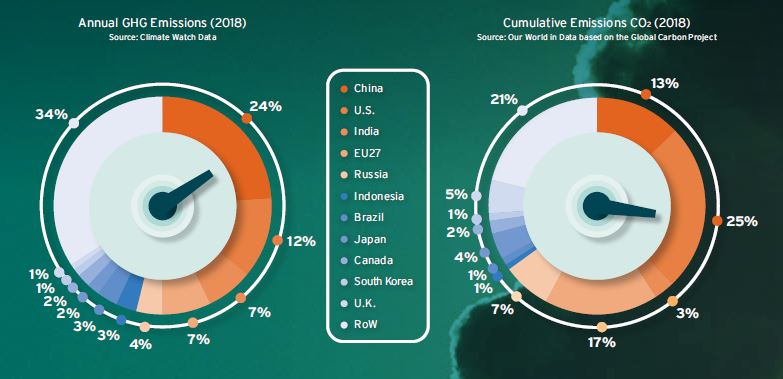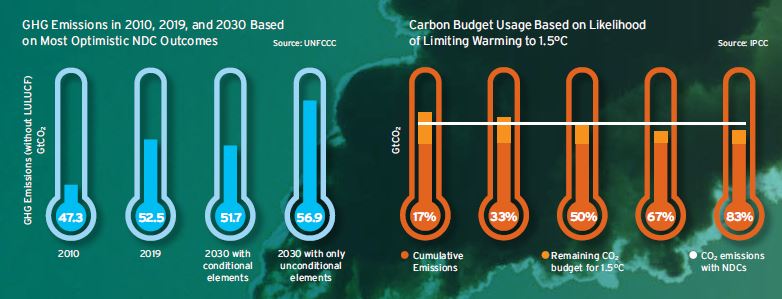For most people the answer is a resounding, “No.” Sadly, ignorance is not bliss in this situation; the reality is we still have a mountain to climb and we are lacking much of the equipment needed to scale it.
While the COP21 in Paris six years ago is recognized by most as a resounding success, progress to the agreed upon conference goals, at least from individual nations, has failed to live up to promise — both in terms of actions to date and future intentions. If we add up all of the current NDCs (national determined contributions — essentially each country’s individual plan to stay within a 1.5 degree Celsius world — the aggregate effect in 2030 would be for emissions of around 55 gigatonnes (Gt) of carbon dioxide equivalent (CO2e). This represents an emissions reduction of just 1% versus 2019 and a 9% increase since 2010 if the conditional elements of NDCs are included. However, the International Panel on Climate Change (IPCC) tells us that in order to meet their 1.5 degree Celsius scenario, emissions by 2030 would need to fall by 45% versus 2010 levels. So current efforts are not even reducing emissions, let alone heading towards net zero. Looking at it in a different way, the Paris scenario would all but use up the entire “carbon budget” (the amount we can emit before temperatures rise above 1.5 degrees Celsius) by 2030, meaning that even to stand a 50% chance of staying below 1.5 degrees Celsius, our emissions would then have to magically drop to zero — which is clearly a fantasy.
What is going on? If we all know about climate change, and 191 countries have signed up to the Paris Agreement to limit temperature increases to 1.5 degrees Celsius, how is it possible that emissions in 2030, even with each country’s “efforts,” will barely change? The simple answer is, “growth.” While emissions have fallen and continue to fall in many developed markets, emissions from developing markets continue to grow significantly. This is for a variety of reasons. Economic development brings greater levels of wealth and demand for autos, white goods, holidays etc. In addition, the pace of growth, in countries where resources are limited, often means going for the fastest and cheapest upfront forms of energy, which are often carbon intensive — even if low-carbon alternatives might be cheaper in the long run.
Does this mean our current situation is all the fault of emerging markets? Not really. Emissions per capita are significantly higher in developed markets, and moreover, the vast majority of the carbon budget has been used up historically by developed nations, in particular the EU and the U.S. Therefore, while current emissions and future growth might be all down to emerging markets, it is very much the fault of developed markets that we are where we are. So, do developed nations have the moral right to tell emerging markets they cannot be afforded the same leeway in economic development which developed markets had historically? And by doing that, can they effectively consign large swaths of the population to slower economic development, and at the extremes, consign millions to poverty for many years longer than might otherwise be the case?
Simply put, to stand any chance of staying within a 1.5-degree Celsius temperature increase, we need to do much, much more to reduce emissions. Moreover, we cannot realistically expect emerging markets to fund their own decarbonization programs, and slow their economic growth and the prospects of their (voting) populaces themselves. The global burden must fall at least in part on developed nations. This would be a tough sell at the best of times, let alone in a massively indebted post-COVID-19 world. Convincing developed market voters they need to subsidize emerging markets — enabling them to compete better with developed markets in the future, with all of the implications for employment and economic growth it entails — will be difficult.
We need to find a mechanism whereby global efforts to decarbonize are funded efficiently and equitably. This is where COP26 can help, and in particular “Article 6,” which looks at ways in which countries can work together — either bilaterally, regionally, or indeed globally — to reduce overall emissions.
The world is a mess when it comes to carbon regimes — there are currently 64 carbon pricing systems globally, with another 30+ in development. Thirty of the existing systems are carbon markets, with the remaining 34 carbon tax regimes. Not only is there no agreement on a mechanism, but the prices within these regimes vary from the meaningless $0.10/tonne to an eye-watering $142.40/tonne — against a price widely seen as necessary now for Paris-alignment of $40-$80/tonne. This fragmented approach is clearly inefficient, and evidence tells us that so far, it is proving ineffective at a global level. Accordingly, to achieve real progress, we must find some way of integrating these individual regimes into one globally-fungible system. There are essentially four ways we could achieve this, using one, or a combination, of the methods mentioned below:
The first option is essentially via command and control directives, where governments/regulators simply mandate the amount of emissions that are allowed when and from which industries, with non-compliance penalized severely. While potentially effective, this is unlikely to be efficient, and almost certainly would not provide the lowest cost solution. This leads us to the three other, market-based solutions (which, it should be pointed out, are not mutually exclusive):
- The first of these is a carbon tax on emissions, which could either be applied as a flat rate globally, or with differing rates for emerging and developed markets, potentially with differing ratcheting up speeds, to eventually bring the world into alignment.
- The second option involves cap and trade systems, whereby allowances for emissions are granted and/or auctioned up to a (reducing) limit, with parties showing faster than prescribed progress allowed to sell their excess allowances to other slower moving parties — while still reaching the same cap.
- The third option involves baseline and credit systems, whereby parties earn credits for reducing emissions, which could be sold to others in deficit, potentially within one of the two preceding mechanisms.
Each of these is fraught with complexities, both technical, and perhaps more importantly, political. Discussion of the pros and cons of each of these methods, the pitfalls and stumbling blocks, as well as how they might be implemented, forms the basis of this report.
There are essentially two key problems common to all of the four methods — who pays for decarbonization, and assuming we successfully raise the money, how, and most importantly where, does the money get spent/distributed?
Bottom line, as already noted above, there will need to be some transfer of value from developed markets to emerging markets. Putting a price on carbon has the potential to drive the adoption of CBAMs (Carbon Border Adjustment Mechanisms), essentially taxing carbon-intensive imports that are not subject to an equivalent carbon regime in line with that of the importing country/bloc. Countries that either do not take action, or do not do so at the “required” rate, could potentially see themselves become international pariahs, in both political and economic/trade terms. As the Citi Global Insights Sustainable Finance team points out in a recent report, cross-border carbon has the potential to become one the biggest factors in global trade over the coming years and decades. The problem, is that a large proportion of carbon-intensive manufacturing is carried out in emerging markets, and hence CBAMs could actually cause money to flow in the opposite direction to that which we are trying to achieve — even if they might encourage other countries to decarbonize faster (to avoid taxes being applied to their exports).
The second issue of how to allocate revenues is also a thorny one. Should revenue raised from, for example, carbon taxes remain in the country where it is raised, helping the less fortunate to cover the inevitably higher cost of goods that will result? Undoubtedly some should, but the reality is that for many emerging markets, a carbon tax could represent a crippling sum — in some cases as much as 20% of GDP. The impact of this on growth could be so dramatic as to make it unfeasible, and hence the need for capital flows from developed markets. One novel idea, which we propose in this report, is the creation of a climate development bank along the lines of existing development finance institutions. The bank would be funded collectively by nations and could take some/all of the receipts from global regimes and reallocate them around the world into lower carbon development. While not without issues, this would at least provide a coordinated and specialized approach, and would also present an enormous opportunity to harness the trillions of dollars of private capital that wants to invest sustainably, by adopting a blended finance approach.
In summary, if we really are serious about tackling climate change and avoiding the resulting economic, social, and environmental decimation, we need to do much, much more, and we need to start working with each other to achieve our shared goals. There are no easy solutions, either economically or politically. However, we should not see these solutions as a cost. If approached correctly, the significant economic multiplier effects — even before we start to consider the environment and social multiplier effects — are compelling on their own. However, politics being politics, reaching a universal agreement in Glasgow will be tough, and hence it may be that the most likely outcome is the formation of so-called climate clubs — for example the U.S. and EU acting in concert and applying CBAMs to third-party countries that are not willing to pick up the baton (or move fast enough) to ultimately encourage a similar level of ambition.
Whatever the outcome of COP26 in Glasgow, a mountain lies before us that absolutely must be climbed — by all of us, collectively. If we are successful, the view at the top looking forward would be spectacular, and who knows, could even usher in an era of greater global cooperation. If we fail to climb it by choice though, rising temperatures and sea levels might push us up that slope unwillingly, by which time it would be too late to turn back the clock. Either way, we are going up that slope, and we might as well do it on our terms now, in the cheapest way possible, and have the option to return down the mountain again when it is safe — rather than being stuck up that mountain, remembering what the world used to be like.



